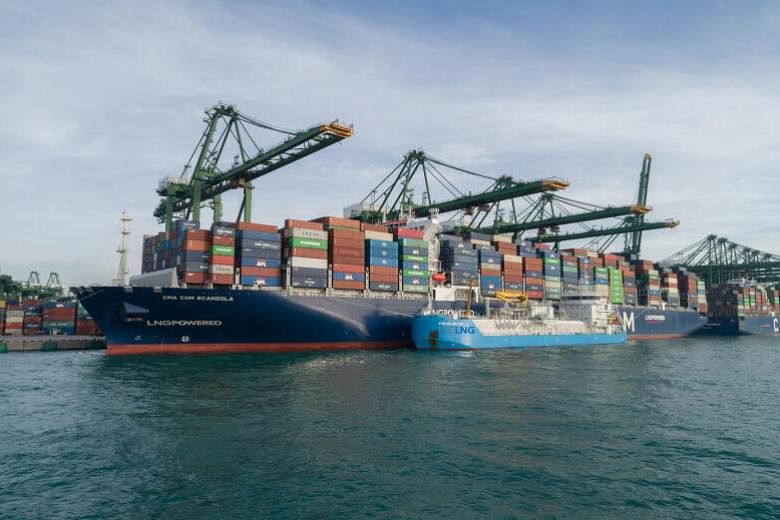SINGAPORE - The push to adopt cleaner fuels in the maritime sector in Singapore reached a significant milestone on Wednesday (March 24), as it became the first port in Asia where a container ship powered by liquefied natural gas (LNG) was refuelled by another ship.
As the CMA CGM Scandola loaded and unloaded cargo at Pasir Panjang Terminal, the container ship, which has a capacity of 15,000 TEUs or twenty-foot equivalent unit containers, was being supplied with 7,100 cubic m of LNG by the FueLNG Bellina, Singapore's first LNG bunkering vessel.
This is Asia's first ship-to-ship LNG bunkering operation with simultaneous cargo operations, said Senior Minister of State for Transport Chee Hong Tat, who attended Wednesday's event. Bunkering is the process of supplying fuels to ships.
The simultaneous operation shortens the time ships need to stay in port, and paves the way for larger LNG-powered vessels to call at Singapore for refuelling.
The Republic is already the world's largest marine refuelling hub, selling close to 50 million tonnes of bunker fuel each year. Wednesday's operation is a major step in Singapore's ambitions to become the leading hub for LNG bunkering in Asia and beyond.
Shell's LNG Outlook report says there are about 400 LNG-fuelled ships in operation or on order. Global LNG bunkering demand is expected to grow to 30 to 50 million tonnes per year by 2040.
Mr Chee acknowledged that LNG is not perfect and still emits carbon emissions. But it is a viable transitional fuel, he said.
While LNG produces 20 per cent less carbon dioxide compared with traditional marine fuels and has close to zero sulphur emissions, there remain questions over the cost of retrofitting existing ships to use LNG and the impact switching to LNG will have on the environment.
Mr Chee noted Singapore's commitment to supporting the International Maritime Organisation's goal of halving the shipping industry's greenhouse gas emissions by 2050 from 2008 levels, but said this cannot happen overnight.
"The industry will need to transition, and in the meantime, we want to choose a solution that is better than what is traditionally available," he said. "We are actively working with industry partners and research institutions to try and find even better, even cleaner fuel sources. In order for these solutions to be commercially viable, it will take time."
Besides cleaner fuels, the maritime sector is also looking at how to reduce carbon emissions in other parts of the supply chain, such as port operations and logistics, he said.
"If we can do this well, it is actually a win-win. It's good for the environment but it is also good for business, because you reduce wastage, you improve efficiency and you cut down waiting times," he added.
The CMA CGM Scandola is the first of six new 15,000-TEU LNG-powered container ships that will bunker in Singapore in the coming months, said CMA CGM Asia Pacific chief executive Stephane Courquin.
Wednesday's operation, which started at 4am in the morning, was facilitated by two LNG-powered tugboats that guided the container ship to berth, he said. The operation is due to be completed later in the evening. Once refuelled, the ship will set sail for the Mediterranean with more than 14,800 containers comprising household goods, electronics, machinery and personal protective equipment.
This is the FueLNG Bellina's first LNG bunkering operation. The ship, which was delivered to Singapore in January, has a capacity of 7,500 cu m and is scheduled to bunker more container ships and tankers in the coming months.
FueLNG, a joint venture between Keppel Offshore and Marine and Shell Eastern Petroleum, said it expects to provide 30 to 50 ship-to-ship bunkering operations this year.
FueLNG chairman and Keppel Offshore and Marine chief executive, Mr Chris Ong, said the ship was ordered in 2018, when the LNG bunker pipeline here was still nascent.
"The decision has now given us an advantage and allowed FueLNG to be an early mover for ship-to-ship bunkering... With the commencement of ship-to-ship bunkering in Singapore this year, we anticipate that annual LNG bunkering volumes can increase by about 80 to 90 times," he said.
Shell Singapore chairman, Ms Aw Kah Peng, said the need to tackle climate change is urgent and it is imperative that the shipping sector immediately deploys the cleanest fuels available today.
"For the foreseeable future, we believe that LNG is the obvious choice for new builds to ensure that we are not adding heavier emitters into the global fleet while we work hard at developing zero-emission fuels for the future," she said.
"In many ways, we are still just at the very beginning of seeing what is possible because there is much more that needs to be done to rapidly scale the use of LNG in shipping."


